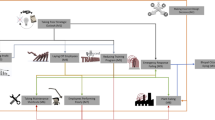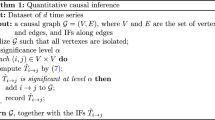Abstract
A new class of bipartite causality maps is developed in this work to model influences in socio-technological systems. Unlike earlier forms of causality maps such as fuzzy cognitive maps, this novel approach uses two kinds of elements represented as different types of graph nodes. Based on the P-graph framework, “objects” and their “mechanisms” (or actions) are represented by O-type and M-type nodes, respectively. Objects consist of both tangible (e.g., technologies) and intangible (e.g., policies) elements, while mechanisms are the roles that objects play within the system. Objects in the network influence each other through these mechanisms as indicated by arcs. Two P-graph algorithms are used for this application. First, the maximal structure generation (MSG) is used to generate a maximal causality map based on specifications of local links of individual objects; the causality map assembly is automatic and does not require human understanding of the global problem topology. Next, the solution structure generation (SSG) algorithm is used to algorithmically generate all structurally feasible causality maps for the problem. The alternative networks can be evaluated to gauge practically viable candidate policy and technology combinations. Criticality of different objects can be quantified based on the frequency of occurrence in the enumerated causality maps. The methodology is illustrated using a case study on a policy framework for negative emissions technologies (NETs) for CO2 removal. The potential of this technique to determine how to sustain “virtuous networks” or to deactivate “vicious networks” is also discussed.








Similar content being viewed by others
References
Andersson C, Törnberg P (2018) Wickedness and the anatomy of complexity. Futures 95:118–138
Aviso KB, Cayamanda CD, Solis FDB, Danga AMR, Promentilla MAB, Yu KDS, Santos JR, Tan RR (2015) P-graph approach for GDP-optimal allocation of resources, commodities and capital in economic systems under climate change-induced crisis conditions. J Clean Prod 92:308–317
Axelrod R (1976) Structure of decision: the cognitive maps of political elites. Princeton University Press, Princeton
Bertók B, Barany M, Friedler F (2013) Generating and analyzing mathematical programming models of conceptual process design by P-graph software. Ind Eng Chem Res 52:166–171
Eden C (2004) Analyzing cognitive maps to help structure issues or problems. Eur J Oper Res 159:673–686
Felix G, Napoles G, Falcon R, Froelich W, Vanhoof K, Bello R (2019) A review on methods and software for fuzzy cognitive maps. Artif Intell Rev 52:1707–1737
Friedler F, Tarjan K, Huang YW, Fan LT (1992a) Combinatorial algorithms for process synthesis. Comput Chem Eng 16:S313–S320
Friedler F, Tarján K, Huang YW, Fan LT (1992b) Graph-theoretic approach to process synthesis: axioms and theorems. Chem Eng Sci 47:1973–1988
Friedler F, Tarjan K, Huang YW, Fan LT (1993) Graph-theoretic approach to process synthesis: polynomial algorithm for maximal structure generation. Comput Chem Eng 17:929–942
Friedler F, Varga JB, Feher E, Fan LT (1996) Combinatorially accelerated branch-and-bound method for solving the MIP model of process network synthesis. In: Floudas CA, Pardalos PM (eds) State of the art in global optimization: computational methods and applications. Springer, Dordrecht, pp 609–626
Friedler F, Aviso KB, Bertók B, Foo DCY, Tan RR (2019) Prospects and challenges for chemical process synthesis with P-graph. Curr Opin Chem Eng 26:58–64
Fuss S, Lamb WF, Callaghan MW, Hilaire J, Creutzig F, Amann T, Beringer T, De Oliveira Garcia W, Hartmann J, Khanna T, Luderer G, Nemet GF, Rogelj J, Smith P, Vicente Vicente JL, Wilcox J, Del Mar Zamora Dominguez M, Minx JC (2018) Negative emissions – part 2: costs, potentials and side effects. Environ Res Lett 13:063002
Haszeldine RS, Flude S, Johnson G, Scott V (2018) Negative emissions technologies and carbon capture and storage to achieve the Paris Agreement commitments. Philos Trans R Soc A Math Phys Eng Sci. https://doi.org/10.1098/rsta.2016.0447
How BS, Teng SY, Leong WD, Ng WPQ, Lim CH, Ngan SL, Lam HL (2019) Non-linear programming via P-graph framework. Chem Eng Trans 76:499–504
Intergovernmental Panel on Climate Change (2018) Summary for policymakers. In: Masson-Delmotte V, Zhai P, Pörtner HO, Roberts D, Skea J, Shukla PR, Pirani A, Moufouma-Okia W, Péan C, Pidcock R, Connors S, Matthews JBR, Chen Y, Zhou X, Gomis MI, Lonnoy E, Maycock T, Tignor M, Waterfield T (eds.), Global Warming of 1.5°C. An IPCC Special Report on the impacts of global warming of 1.5°C above pre-industrial levels and related global greenhouse gas emission pathways, in the context of strengthening the global response to the threat of climate change, sustainable development, and efforts to eradicate poverty. World Meteorological Organization, Geneva
Kosko B (1986) Fuzzy cognitive maps. Int J Man-Mach Stud 24:65–75
Kosko B (1988) Hidden patterns in combined and adaptive knowledge networks. Int J Approx Reason 2:377–393
Kovács Z, Ercsey Z, Friedler F, Fan LT (2000) Separation-network synthesis: global optimum through rigorous super-structure. Comput Chem Eng 24:1881–1900
Lakner R, Friedler F, Bertók B (2017) Synthesis and analysis of process networks by joint application of P-graphs and Petri nets. In: van der Aalst W, Best E (eds) Application and theory of Petri nets and concurrency. PETRI NETS 2017. Lecture Notes in Computer Science, vol 10258. Springer, Cham
Lao A, Cabezas H, Orosz A, Friedler F, Tan R (2020) Socio-ecological network structures from process graphs. PLoS One 15:e0232384
Minx JC, Lamb WF, Callaghan MW, Fuss S, Hilaire J, Creutzig F, Amann T, Beringer T, De Oliveira Garcia W, Hartmann J, Khanna T, Lenzi D, Luderer G, Nemet GF, Rogelj J, Smith P, Vicente Vicente JL, Wilcox J, Del Mar Zamora Dominguez M (2018) Negative emissions – part 1: research landscape and synthesis. Environ Res Lett 13:063001
Papageorgiou, E., 2014, Fuzzy cognitive maps for applied sciences and engineering: from fundamentals to extensions and learning algorithms. Springer-Verlag, Berlin
Papageorgiou E, Salmeron J (2013) A review of fuzzy cognitive map research during the last decade. IEEE Trans Fuzzy Syst 21:66–79
P-graph Studio (2020) Accessed at www.p-graph.org on November 16, 2020
Pimentel J, Orosz A, Tan RR, Friedler F (2020) Automated synthesis of process-networks by the integration of P-graph with process simulation. Chem Eng Trans 81:1171–1176
Tan RR, Aviso KB, Klemeš JJ, Lam HL, Varbanov PS, Friedler F (2018) Towards generalized process networks: prospective new research frontiers for the P-graph framework. Chem Eng Trans 70:91–96
Trope Y, Liberman N (2010) Construal-level theory of psychological distance. Psychol Rev 117:440–463
Acknowledgments
We are grateful to the P-graph Studio development and technical support team based in the University of Pannonia, Hungary.
Author information
Authors and Affiliations
Corresponding author
Ethics declarations
Conflict of Interest
The authors declare that they have no conflict of interest.
Additional information
Publisher’s Note
Springer Nature remains neutral with regard to jurisdictional claims in published maps and institutional affiliations.
Appendix. Alternative causality networks generated by SSG
Appendix. Alternative causality networks generated by SSG
Rights and permissions
About this article
Cite this article
Tan, R.R., Aviso, K.B., Lao, A.R. et al. P-graph Causality Maps. Process Integr Optim Sustain 5, 319–334 (2021). https://doi.org/10.1007/s41660-020-00147-2
Received:
Revised:
Accepted:
Published:
Issue Date:
DOI: https://doi.org/10.1007/s41660-020-00147-2













